This four-image NAVCAM mosaic comprises images taken on 6 November from a distance of 30.5 km from the centre of Comet 67P/C-G.
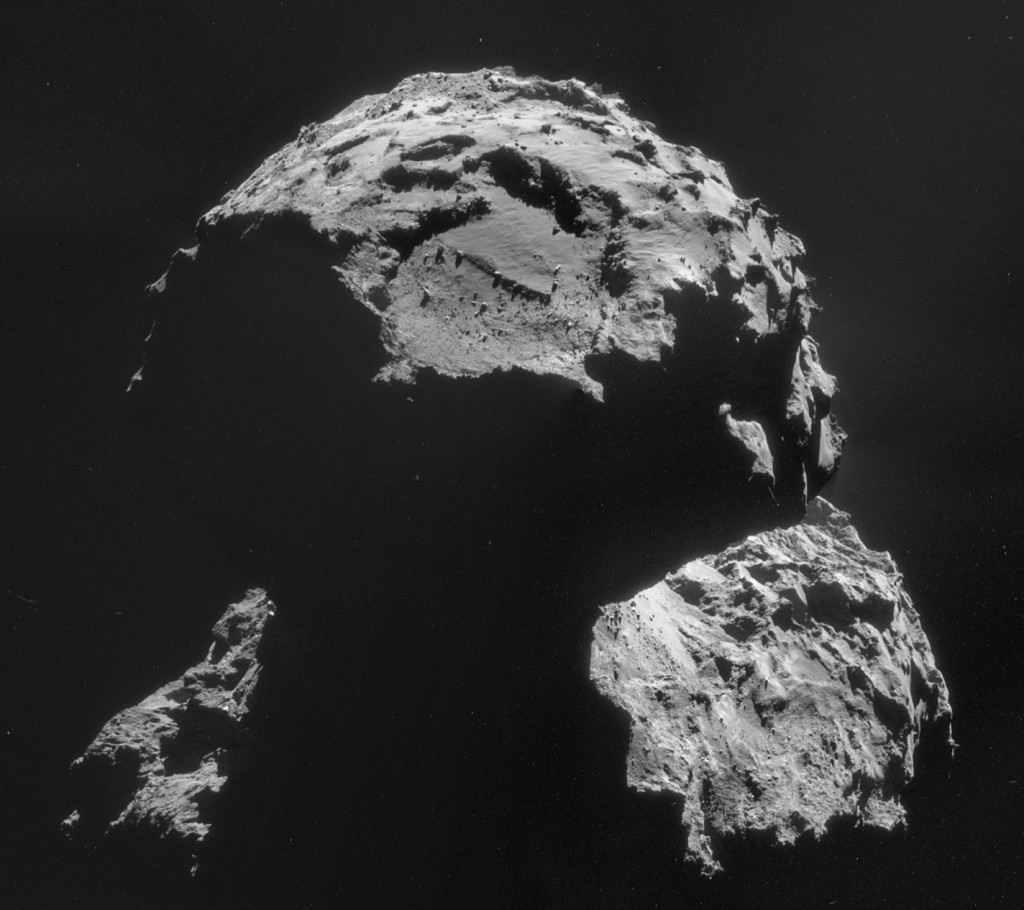
Four image mosaic of Comet 67P/C-G comprising images taken on 6 November. Credits: ESA/Rosetta/NAVCAM, CC BY-SA IGO 3.0
The image resolution is 2.6 m/pixel. The mosaic has been slightly rotated and cropped, and measures 3.7 x 3.2 km. Due to rotation and translation of the comet during the image taking sequence, making a mosaic involves some compromises. However, as always, the individual images have also been made available below to allow you to check the accuracy of the mosaicing and intensity matching.
The Agilkia landing site can be seen at the ‘top’ of the image ‘above’ the easily recognisable depression that characterises the smaller of the comet’s two lobes.
This image was featured as today’s Space Science image of the week.

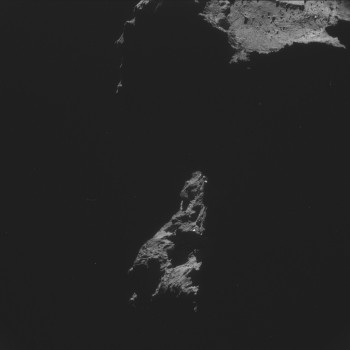
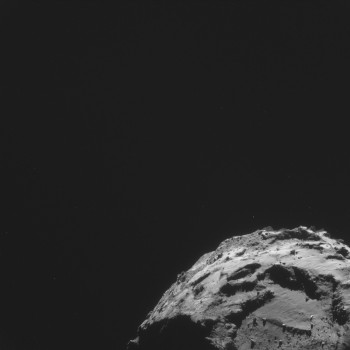
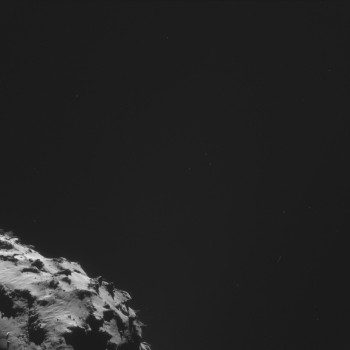

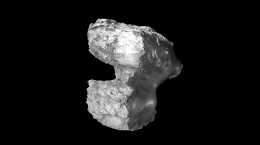
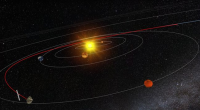
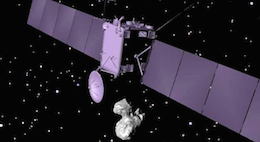

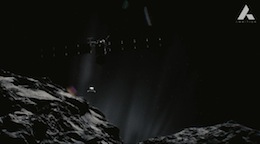
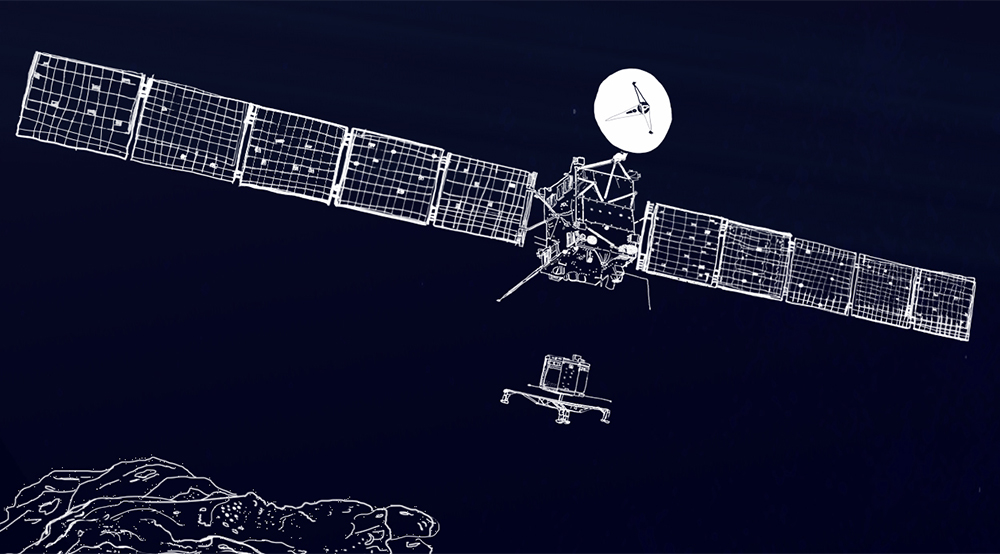
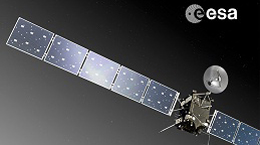
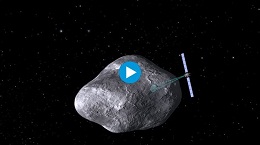
Discussion: 17 comments
Impressive and ominous at the same time…Now let’s go for the bull’s eye and a succesful landing!
Amazing!!!Go!Philae!
Thanks, Team– another info-packed NAVCAM image. Not as much gee-whiz value as a OSIRIS, but still great (though, 😉 😉 , an OSIRIS of the Agilkia region from this perspective/lighting would be super).
More in reply…
–Bill
Perhaps the OSIRIS images will start flowing once Philae is posed for snapshots.
Here is an enlarged and sharpened Perspective View of Agilkia landing area from the 11 Nov 14 Navcam,
CC: BY-SA IGO 3.0
https://creativecommons.org/licenses/by-sa/3.0/igo/
https://univ.smugmug.com/Rosetta-Philae-Mission/Philae/i-RwsqZjj/0/L/ESA_Rosetta_NAVCAM_141106_B-C_montage-L.png
–Bill
Presenting a “Sightseeing” Map for Philae
This is the current low-perspective image of the Agilkia region combined with an earlier image with a more vertical perspective. Several landmarks, along with the landing sites, have been marked. Although this is a small world with a close horizon minor elevation differences can have a large effect on the sight distances so there is no telling what may be visible from the actual landing location.
The nominal landing location is shown with a red line and the other landmarks are shown with blue lines. A probable Northern horizon is shown in green. Two high peaks at the “edge of the world” that may peek over the local horizon are designated with a yellow “A” and “B”.
Image Source: ESA/Rosetta/NAVCAM CC: BY-SA IGO 3.0
https://creativecommons.org/licenses/by-sa/3.0/igo/
https://univ.smugmug.com/Rosetta-Philae-Mission/Philae/i-gZKNCH4/0/L/NAVCAM_141106_B-C_%2B_NAVCAM_140914-L.png
–Bill
Beautiful. What does the roughness of the surface and shape tell us about the relative age or water content of the comet? Is this perhaps a young icy comet or an old rocky comet, or is it simply that comets that spend most of their time so far from the Sun stay pitted for most of their lifetime?
I believe this is the first time we’ve seen the ‘easily recognisable depression’ crater from this head-on angle, isn’t it? It appears to have steep vertical walls and a couple craters on the rim as well as a flat bottom. Thanks for this posting Emily. 2 days….to touchdown!
It’s a ‘collapsing’. Doesn’t it, Lodaya?
This is the 6 November ESA-generated mosaic enhanced and annotated (“folded, spindled and mutilated”) to show interesting features.
I’ve shown the Agilkia landing site on the top of the Small Lobe and have approximately outlined my current geomorph-terrain map.
The North Polar Dust Jets are active and visible, and the North Polar Plain is seen just around the edge of the Small Lobe on the right. Straight
shadows are cast on the diffuse coma by the Small Lobe in the foreground, although one of the shadows may have been emphasized by the montage stitching process. And, of course, the pervasive “coma snow” is visible.
Good work, ESA.
https://univ.smugmug.com/Rosetta-Philae-Mission/Rosetta-Geomorphology/i-PGqpqBQ/0/L/ESA_Rosetta_NAVCAM_141106_Mosaic–enh–annot-L.png
–Bill
PS–
More on the geology of the landing area at
https://univ.smugmug.com/Rosetta-Philae-Mission/Rosetta-Geomorphology
The feathery raised Lichtenberg figure in the dust in the upper-right section of the large crater looks amazing (lower-left of image C). An electric discharge running through the surface is likely the cause of the dune-like structures on the neck as well… similar to the sub-surface sparking observed on the moon (https://phys.org/news/2014-08-electric-evolution-lunar-soil.html).
This is getting better and better. These images are fantastic. It is truly amazing.
Best of luck for tomorrow’s momentous events.
Thanks Emily, yet another intriguing view of this strangely shaped object. The impression of how it all fits together changes almost every time. We have seen many different viewpoints from NAVCAM, but this different perspective makes the neck joining the body out to be very slender and the head seems precariously stuck on top of it as if it might snap off at any time. In a few months time more of the “Dark Side” hopefully will be revealed, if its not hidden in a fog of ejecta.
The top half of the image, the Northern hemisphere is covered in the dusty surface layer, but as you move down the image moving further South, the amount of dust gets less and less. The big crater on the head, formerly Landing Site B, lies across the equator. The upper half of the crater is covered in an even coating of dust. At the near, southern edge the subsurface layer is almost completely bare and the crater walls have been eroded flat.
On the left of the image we have another glimpse of the “Dark Side” of the body lobe. This area is almost completely devoid of dust and the surface pitted with tiny indentations. Again that impression of extruded formations, bulbous and rounded, unlike the more jagged edged shapes we see in the North. There are almost no loose boulders and rubble. Just above Agilkia the cliffs and ridges are all crumbly and scree strewn. This suggests to me these southern areas have undergone very recent metamorphosis brought about by exposure to the heat at Perihelion, possibly involving the melting of the surface and subsurface layers. The big trench of the Northern polar neck area and its method of formation and evolution, becomes more intriguing by the day.
Good luck to Philae and all those on the Rosetta team for Wednesday.
Good view of the landing site.
Hi Philae, Have a great journey…Bon voyage!!!
All the best for Rosetta Team.
The neck seems about 40% of the width of the head and about 30% the width of the larger lobe.
Very exciting. It’s 6:05 PM here in Los Angeles. Looking forward to the successful landing!
In the meantime, CONGRATULATIONS!
…Rowby
Good luck Rosetta team!
Thank you for these amazing moments!